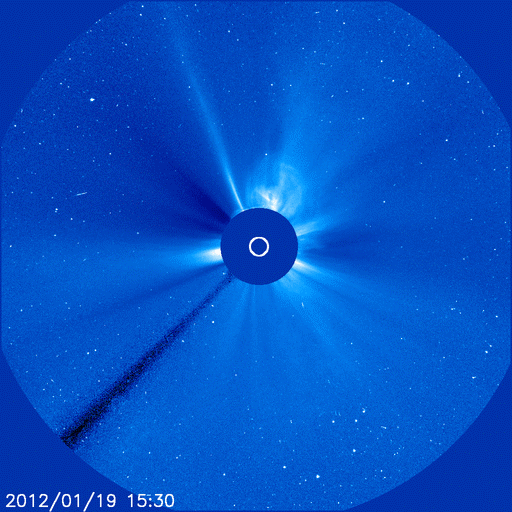
Active sunspot 1401 erupted two days ago, producing an M3-class solar flare and a coronal mass ejection (CME). The CME’s expanding cloud is heading almost directly toward Earth and is due to strike today (January 21, 2012) 22:30 UTC (16:30 CST) +/- 7 hrs. That makes tonight a grand time to look for beautiful aurorae or northern lights. Since Earth and Mars are nearly in alignment now – both on one side of the sun – the expanding cloud is also headed toward Mars, due to strike on January 24.
The eruption took place at January 19, 2012, at around 16:30 UTC (12:30 CST). The image above shows the full-halo CME, or expanding cloud from the sun.
Solar flares are giant explosions on the sun that send energy, light and high speed particles into space. These flares are often associated with solar magnetic storms (coronal mass ejections, or CMEs). When these storms from the sun strike Earth, they can produce geomagnetic storms that affect earthly telecommunications and also satellites in orbit. If your cell phone is acting up today, blame the sun.
Looking for this? Strongest solar radiation storm in 7 years expected January 24
This beautiful video, from the Atmospheric Imaging Assembly (AIA) aboard NASA Solar Dynamics Observatory, shows sunspot 1401 and 1402 three days before the solar flare that produced the CME now headed to Earth. The instrument is essentially a series of cameras set up to take images of the sun every few seconds and through a variety of filters. This video is a 11-hour series of data. The video shows activity in AR11401 and AR11402 on January 16, 2012 from 03 to 14 UTC. There are almost 1,100 images used to make the frames for the video, so you’re seeing real time sped up by almost 1,000 times.
And what about the fact that the CME is also headed to Mars? Earth and Mars are on the same side of the sun now, with Earth due to pass between Mars and the sun on March 3, 2012 for the first time in about two years. So solar events that affect Earth now have a chance of striking Mars, too.
Mars at opposition March 3, 2012
As it happens, we earthlings have a spacecraft on the way to Mars, launched in November 2011. The Mars Science Laboratory – which is carrying a new and advanced Mars rover, called Curiosity, to Mars – is also equipped to study solar storms of this kind. It might be able to detect a change in the energetic particle environment when the CME passes by. Isn’t that cool?
Mars rover Curiosity successfully adjusted trajectory
Bottom line: Sunspot 1401 erupted on January 19, 2012, producing a coronal mass ejection that is due to strike Earth today (January 21, 2012) and Mars on January 24. Disruptions in telecommunications are possible. Watch for the aurora is you are at a high latitude. The Mars Science Laboratory, now en route to Mars, might be able to detect signs of the CME as it passes by.











